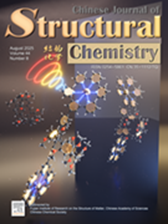
Cover Picture
Metal-coordinate complexes (M = 3d, 4f) with enhanced circularly polarized luminescence in planar chiral pillar[5]arenes
Yu Tian, Yijun Lin, Siyu Deng, Yinghe Tan, Xuanyi Bie, Zhaoyang Chen, Pangkuan Chen* Submit a Manuscript
Metal-coordinate complexes (M = 3d, 4f) with enhanced circularly polarized luminescence in planar chiral pillar[5]arenes
Yu Tian, Yijun Lin, Siyu Deng, Yinghe Tan, Xuanyi Bie, Zhaoyang Chen, Pangkuan Chen* Submit a Manuscript
Metal-coordinate complexes (M = 3d, 4f) with enhanced circularly polarized luminescence in planar chiral pillar[5]arenes
Yu Tian, Yijun Lin, Siyu Deng, Yinghe Tan, Xuanyi Bie, Zhaoyang Chen, Pangkuan Chen*
Chin. J. Struct. Chem., 2025, 44(8), 100626. DOI: 10.1016/j.cjsc.2025.100626
August 1, 2025
Circularly polarized luminescence; Pillar[5]arenes; Metal-coordination; Lanthanides
ABSTRACT
Metal-complexed chiral macrocyclic architectures have attracted increasing research interests in circularly polarized luminescence owing to their distinctive structural and functional attributes. The method of metal coordination has emerged as a robust methodology for chirality induction in many systems. In this work, we engineered two rigid and flexible chiral organic ligands (L1 and L2) by synergizing the inherent planar chirality of pillar[5]arenes with tailored metal-coordination moieties. These ligands demonstrate versatile coordination capabilities toward both 3d- and 4f-block metals, enabling modulation of luminescent characteristics with blue, green and red emissions. Four planar chiral complexes exhibiting CPL activity were synthesized through systematic coordination of L1/L2 with Zn2+, Eu3+, and Tb3+. The coordination processes effectively rigidify molecular conformations, leading to an enhanced CPL performance. Particularly, the Tb-L2 complex displays superior lanthanide-centered emission with a fluorescence quantum yield ∼55% and an emission dissymmetry factor glum = 5.5 × 10-3. Engineering the substitution on pillar[5]arene scaffolds, we have established a metal-coordination platform with CPL characteristics, which provides an advancement in the design of new metal-based luminescent materials.







